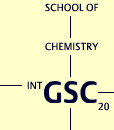 |


![]()
Name: Thomas Wiegand
Diploma / M.Sc degree: Westfälische Wilhelms-Universität Münster, Germany
(March 2010)
PhD Project: Structural investigations on phosphorus-based clusters and frustrated Lewis-pairs by modern solid state NMR techniques
Abstract of Research Project
Solid state NMR spectroscopy is a powerful tool for the structural characterisation of complex systems. In many cases high-resolution magic-angle spinning technique (MAS) allows to discriminate between crystallographically distinct species. Previously, single-crystal X-ray diffractometry has been used as a primary source of structural information, but it has the great disadvantage of requiring suitable crystals and therefore cannot be applied to nanocrystalline or even amorphous materials. Instead, solid state NMR offers a large tool-box of experiments for obtaining structural information, which is a fundamental requirement for the engineering of novel materials. In particular, NMR benefits from the possibility of designing experiments in which selected internal interactions are reintroduced to provide useful information. Prominent examples are the REDOR (Rotational Echo Double Resonance) and RFDR (Radiofrequency Driven Recoupling) experiments. In the first one the applied NMR Hamiltonian leads to a reintroduction of heteronuclear dipolar interactions, while the latter experiment is based on homonuclear dipolar interactions.
The main focus of this project is the development and establishment of modern solid state NMR methods for successfully investigating phosphorus-based clusters and frustrated Lewis-pairs. The first subproject concentrates on the design of a structural concept for the new material class of cationic supramolecular aggregates and ensembles of En ligand complexes of the 15th group (E=P,As,Sb) with weakly coordinating anions (WCA). Despite the well-defined compositions and atomic connectivities of the single molecular building blocks, the structures of the nanocrystalline or amorphous products cannot be predicted. In this work, 2D NMR experiments for the investigation of the connectivities within the cyclo-Pn units will be carried out. Nevertheless, owing to the large spectral dispersion (chemical shift differences and anisotropies), short spin-spin relaxation times (due to strong dipolar couplings between directly-bonded P atoms) and extremely long spin-lattice relaxation times of the 31P nuclei in many inorganic polyphosphide compounds, the choice and optimization of such techiques remains a considerable challenge in this field. To support the assignment, ab initio calculations of magnetic shieldings will be performed for simplifying the analysis of NMR spectra and obtaining a detailed understanding of the origin of the observed shieldings.
The second subproject is based on the structural investigation of frustrated Lewis-pairs (FLPs). The high interest in the chemistry of those molecules is due to the affinity to the activation of small molecules (e.g. di-hydrogen). Here especially the characterisation of intra- and intermolecular phosphine-borane FLPs is in focus. Solid State NMR is well-suited for this project because of the large number of NMR active nuclei present in these compounds (as 1H, 13C, 19F, 11B and 31P). Exploiting double resonance techniques as REDOR, the interaction between Lewis acid and Lewis base will be analyzed with the general aim of obtaining a deeper understanding of the mechanism of the di-hydrogen activation.
Publications
M. Plois, T. Wiegand, R. Wolf
Novel Ruthenium(II) Aluminate Anions: Building Blocks of Unique
Cage Structures
Organometallics 31(24) (2012), 8469-8477.
M. Sajid, A. Klose, B. Birkmann, L. Liang, B. Schirmer, T. Wiegand, H. Eckert, A. J. Lough, R. Fröhlich, C. G. Daniliuc, S. Grimme, D. W. Stephan, G. Kehra, G. Erker
Reactions of phosphorus/boron frustrated Lewis pairs with SO2†
Chem. Sci. 4 (2013), 213–219.
T. Wiegand, H. Eckert, S. Grimme
Solid-State NMR as a Spectroscopic Tool for Characterizing Phosphane–Borane Frustrated Lewis Pairs
Topics in Current Chemistry (2012).
P. Wua, T. Wiegand, H. Eckert, M. Gjikaj
New hypodiphosphates of the alkali metals: Synthesis, crystal structure and vibrational spectra of the hypodiphosphates(IV) M2[(H2P2O6)(H4P2O6)] (M=Rb and Cs)
Journal of Solid State Chemistry 194 (2012), 212–218.
G. Bender, T. Wiegand, H. Eckert, R. Fröhlich, C. G. Daniliuc,
C. Mück-Lichtenfeld, S. Ndambuki, T. Ziegler, G. Kehr, G. Erker
Binding of Molecular Magnesium Hydrides to a Zirconocene–Enyne Template
Angew. Chem. Int. Ed. 51 (2012), 8846–8849.
T. Wiegand, H. Eckert, O. Ekkert, R. Fröhlich, G. Kehr, G. Erker, S. Grimme
New Insights into Frustrated Lewis Pairs: Structural Investigations of Intramolecular Phosphane-Borane Adducts by Using Modern Solid-State NMR Techniques and DFT calculations
Journal of the American Chemical Society 134(9) (2012), 4236-4249.
R. S. Rojas, B. C. Peoples, A. R. Cabrera, M. Valderrama, R. Fröhlich, G. Kehr, G. Erker, T. Wiegand, H. Eckert
Synthesis and Structure of Bifunctional Zirconocene/Borane Complexes and their Activation for Ethylene Polymerization
Organometallics 30 (2011), 6372-6382.
T. Wiegand, H. Eckert, S. Grimme, D. Hoppe, M. Ruck
Structural Characterization of Phosphorus-Based Networks and Clusters: 31P MAS NMR Spectroscopy and Magnetic Shielding Calculations on Hittorf's Phosphorus
Chem. Eur. J. 17 (2011), 8739–8748.
Thomas Wiegand
eMail: Thomas Wiegand